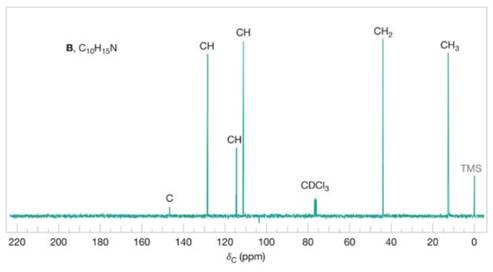
Concept explainers
Compound


FIGURE 20.8 The broadband proton-decoupled
Want to see the full answer?
Check out a sample textbook solution
Chapter 20 Solutions
Organic Chemistry
Additional Science Textbook Solutions
Chemistry: Matter and Change
Chemistry: An Introduction to General, Organic, and Biological Chemistry (13th Edition)
Chemistry (7th Edition)
Chemistry For Changing Times (14th Edition)
Chemistry & Chemical Reactivity
Chemistry: An Introduction to General, Organic, and Biological Chemistry (12th Edition) - Standalone book
- 19. A compound with molecular formula C6H12O2 exhibits two singlets in its 1H NMR spectrum, at d 1.4 (9H) and d 2.0 (3H). Its IR spectrum shows a strong absorption band near 1740 cm-1. What is the structure for this compound? Show the correlation of the spectra with the molecular structure.arrow_forwardA compound of formula C11H16N2 gives the IR, 1H NMR, and 13C NMR spectra shown. The proton NMR peak at δ 2 disappears on shaking with D2 Propose a structure for this compound, and show how your structure accounts for the observed absorptions.arrow_forwardA compound of unknown structure (Compound A) is determined by elemental analysis to have a molecular formula of C10H12. Upon reaction with H2 and Pd/CacO3 the unknown absorbs one mole equivalent of hydrogen gas. Upon reaction with ozone, followed by zinc/acetic acid a product with structure shown is obtained. Four possibilities are given for the structure of Compound A. Select the correct answer. HO,C A B A Both B and C are correctarrow_forward
- Compound I (C11H14O2) is insoluble in water, aqueous acid, and aqueous NaHCO3, but dissolves readily in 10% Na2CO3 and 10% NaOH. When these alkaline solutions are acidified with 10% HCl, compound I is recovered unchanged. Given this information and its 1H-NMR spectrum, deduce the structure of compound I.arrow_forwardDraw the structure of the compound that produced the spectra below. The infrared spectrum has strong bands at 1720 and 1738 cm-1.arrow_forwardA hydrocarbon, compound B, has molecular formula C6H6, and gave an NMR spectrum with two signals: delta 6.55 pm and delta 3.84 pm with peak ratio of 2:1. When warmed in pyridine for three hr, compound B quantitatively converts to benzene. Mild hydrogenation of B yielded another compound C with mass spectrum of m/z 82. Infrared spectrum showed no double bonds; NMR spectrum showed one broad peak at delta 2.34 ppm. With this information, address the following questions. a) How many rings are in compound C? b) How many rings are probably in B? How many double bonds are in B? c) Can you suggest a structure for compounds B and C? d) In the NMR spectrum of B, the up-field signal was a quintet, and the down field signal was a triplet. How must you account for these splitting patterns?arrow_forward
- Briefly explain or give an introduction to this. Structure Elucidation of Compounds using Several Spectroscopic Techniques. 1H and 13C NMR Spectroscopy IR Spectroscopy Mass Spectroscopyarrow_forwardTreatment of compound C (molecular formula C9H12O) with PCC affords D (molecular formula C9H10O). Use the 1H NMR and IR spectra of D to determine the structures of both C and D.arrow_forwardCompounds A and B are isomers having the molecular formula C4H8O3. Identify A and B on the basis of their 1H NMR spectra.Compound A: δ 1.3 (3H, triplet); 3.6 (2H, quartet); 4.1 (2H, singlet); 11.1 (1H, broad singlet)Compound B: δ 2.6 (2H, triplet); 3.4 (3H, singlet); 3.7 (2H triplet); 11.3 (1H, broad singlet)arrow_forward
- Compounds W and X are isomers. They have the molecular formula C9H8O. The IR spectrum ofeach compound shows a strong absorption band near 1715 cm−1. Oxidation of either compound withhot, basic potassium permanganate followed by acidification yields phthalic acid. The proton NMRspectrum of W shows a multiplet at δ 7.3 and a singlet at δ 3.4. The proton NMR spectrum of Xshows a multiplet at δ 7.5, a triplet at δ 3.1, and a triplet at δ 2.5. Propose structures for W and X.arrow_forwardCompounds B and C are isomers with molecular formula C5H9BrO2. The 1H NMR spectrum of compounds B and C are shown below. The IR spectrum corresponding to compound B showed strong absorption bands at 1739, 1225, and 1158 cm-1, while the spectrum corresponding to compound C have strong bands at 1735, 1237, and 1182 cm-1. 1.Based on the information provided, determine the structure of compounds B and C. 2.Assign all peaks in 1H NMR spectrum of compounds B and C.arrow_forwardA compound of unknown structure (Compound A) is determined by elemental analysis to have a molecular formula of C10H12. Upon reaction with H2 and Pd/CacO3 the unknown absorbs one mole equivalent of hydrogen gas. Upon reaction with ozone, followed by zinc/acetic acid a product with structure shown is obtained. Four possibilities are given for the structure of Compound A. Select the correct answer. HO,C B A D В Both B and C are correct O o o o oarrow_forward
 Organic ChemistryChemistryISBN:9781305580350Author:William H. Brown, Brent L. Iverson, Eric Anslyn, Christopher S. FootePublisher:Cengage Learning
Organic ChemistryChemistryISBN:9781305580350Author:William H. Brown, Brent L. Iverson, Eric Anslyn, Christopher S. FootePublisher:Cengage Learning

